An overview of history, culture and society of Hmong people in Thanh Hoa
Hmong people belong to the Hmong - Yao language branch, the South Asian language
family, is one of the ethnic minority groups which has a large number of population among ethnic
groups in Vietnam. Hmong people have the slow migration and settlement process compared to
other ethnic groups in our country. They are located mainly in some highland provinces: Ha
Giang, Tuyen Quang, Dien Bien, Lai Chau, Cao Bang, Lang Son, Lao Cai, Son La, etc. and in the
western mountainous region of Thanh Hoa and Nghe An provinces. Hmong people in Thanh Hoa
reside mainly in three districts: Muong Lat, Quan Son and Quan Hoa. Most of them come from
other places in the northern mountainous areas, migrating through two direct ways. Essentially,
Hmong people in Thanh Hoa have a high sense of ethnicity and also maintain many traditional
cultural features which contribute to enlivening the colorful picture of ethnic culture of Xu Thanh
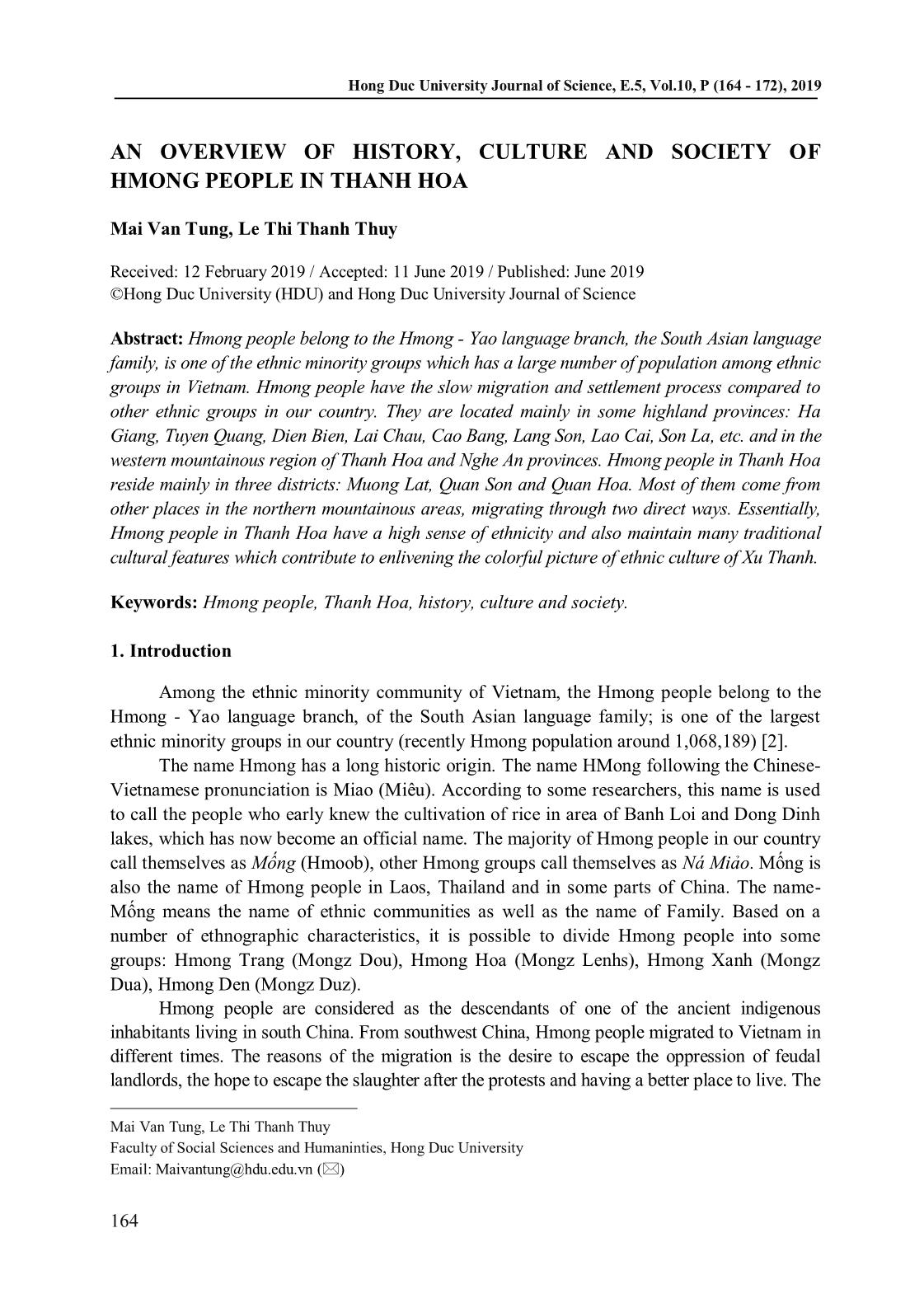
Trang 1
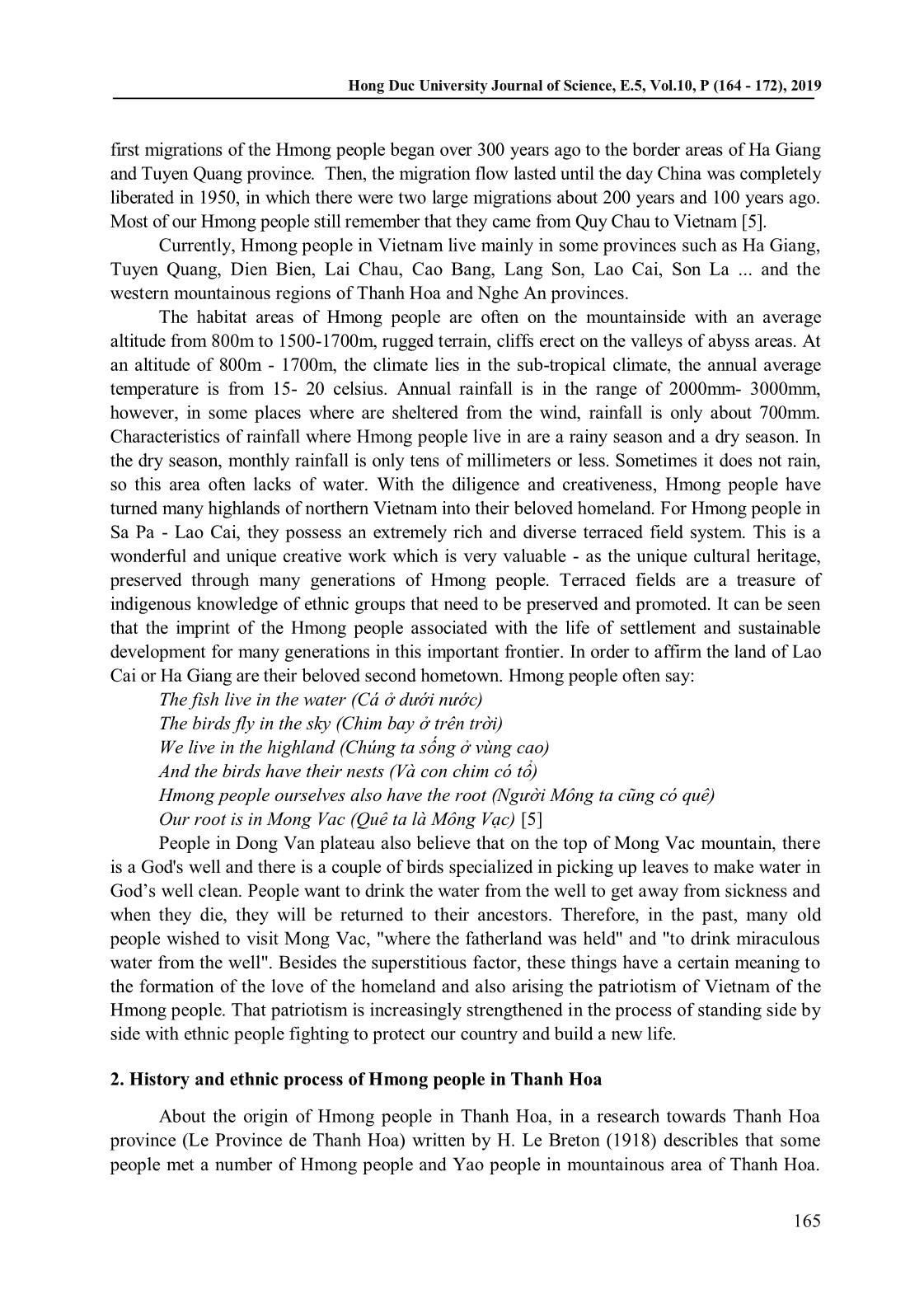
Trang 2
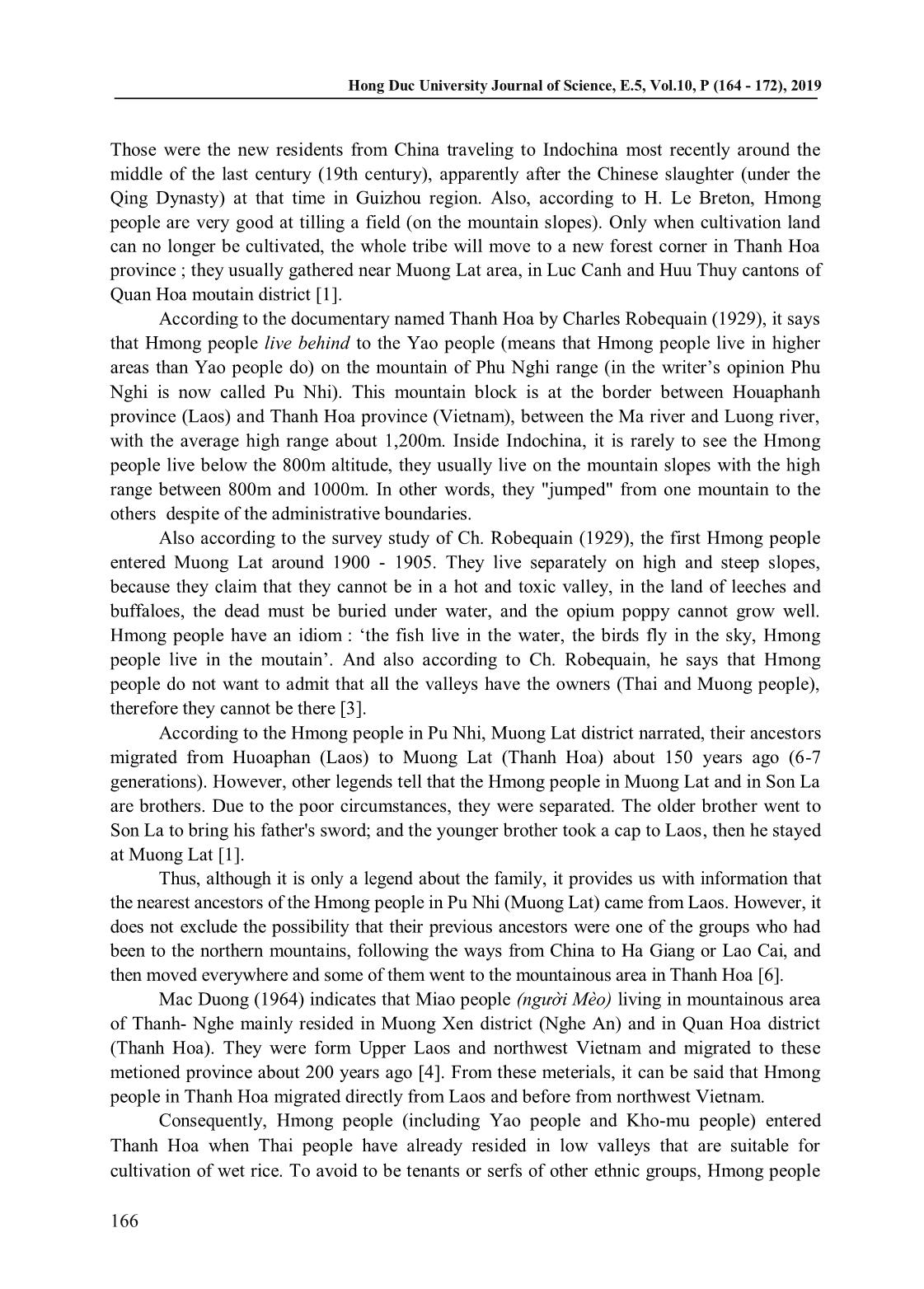
Trang 3
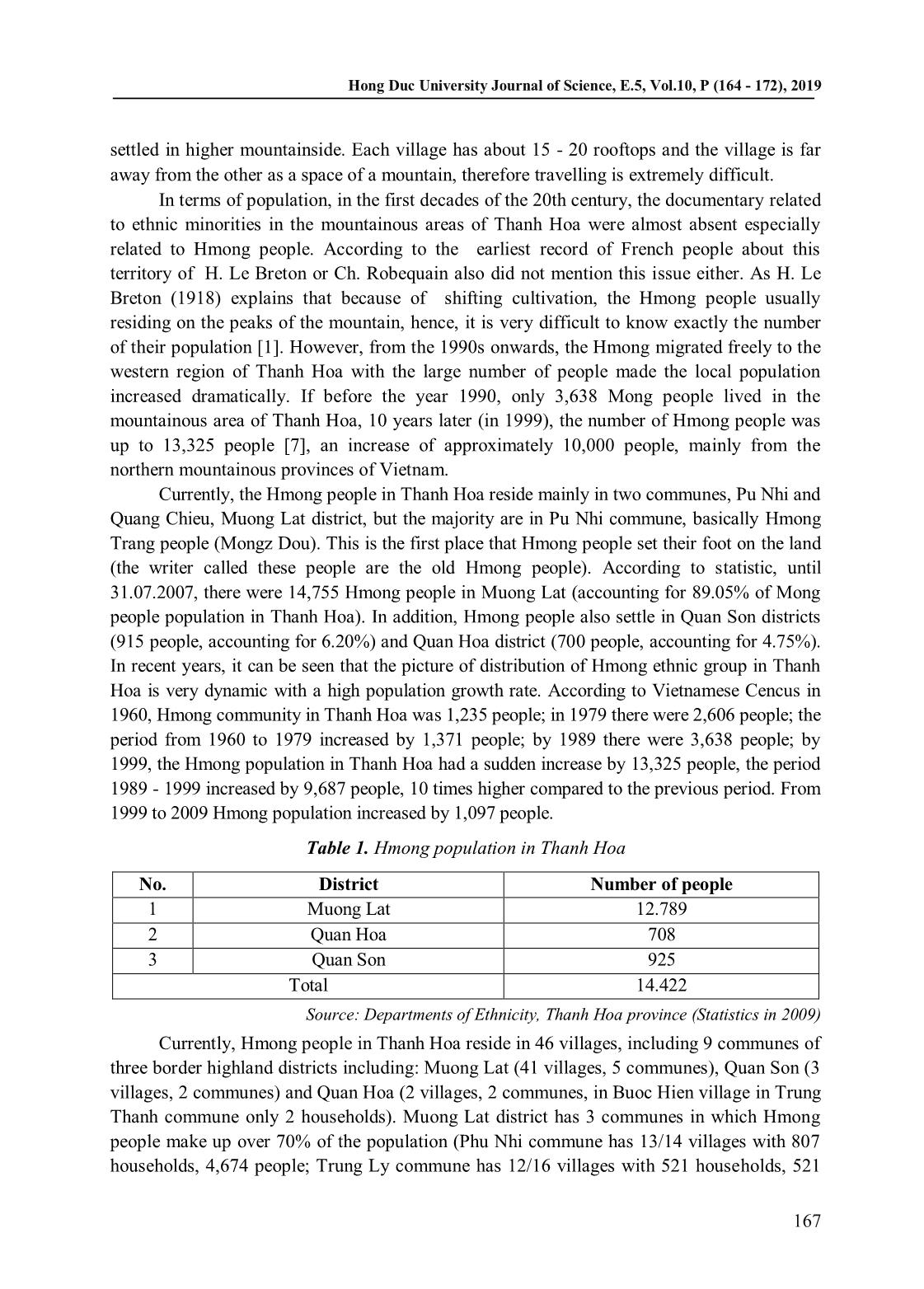
Trang 4
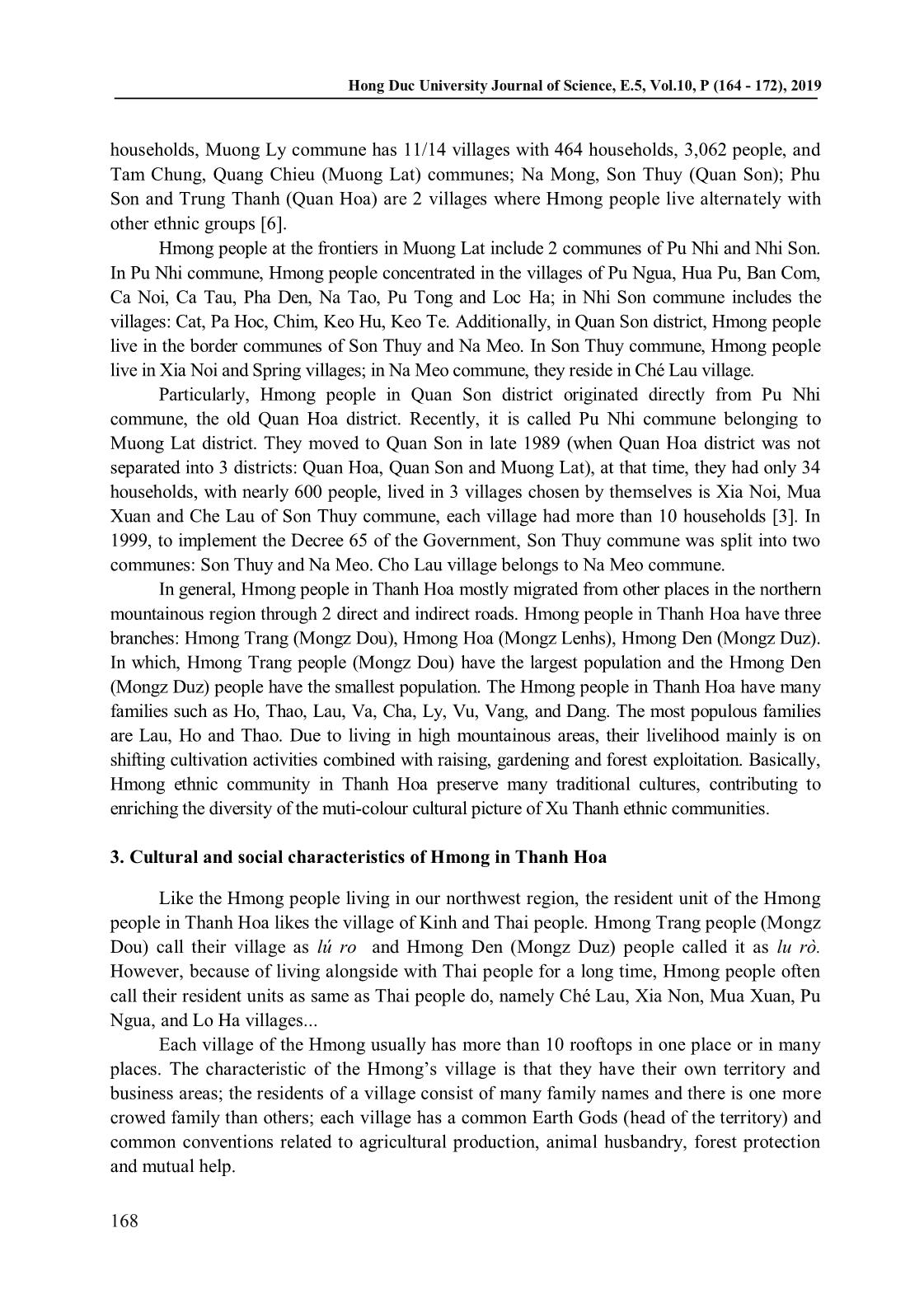
Trang 5
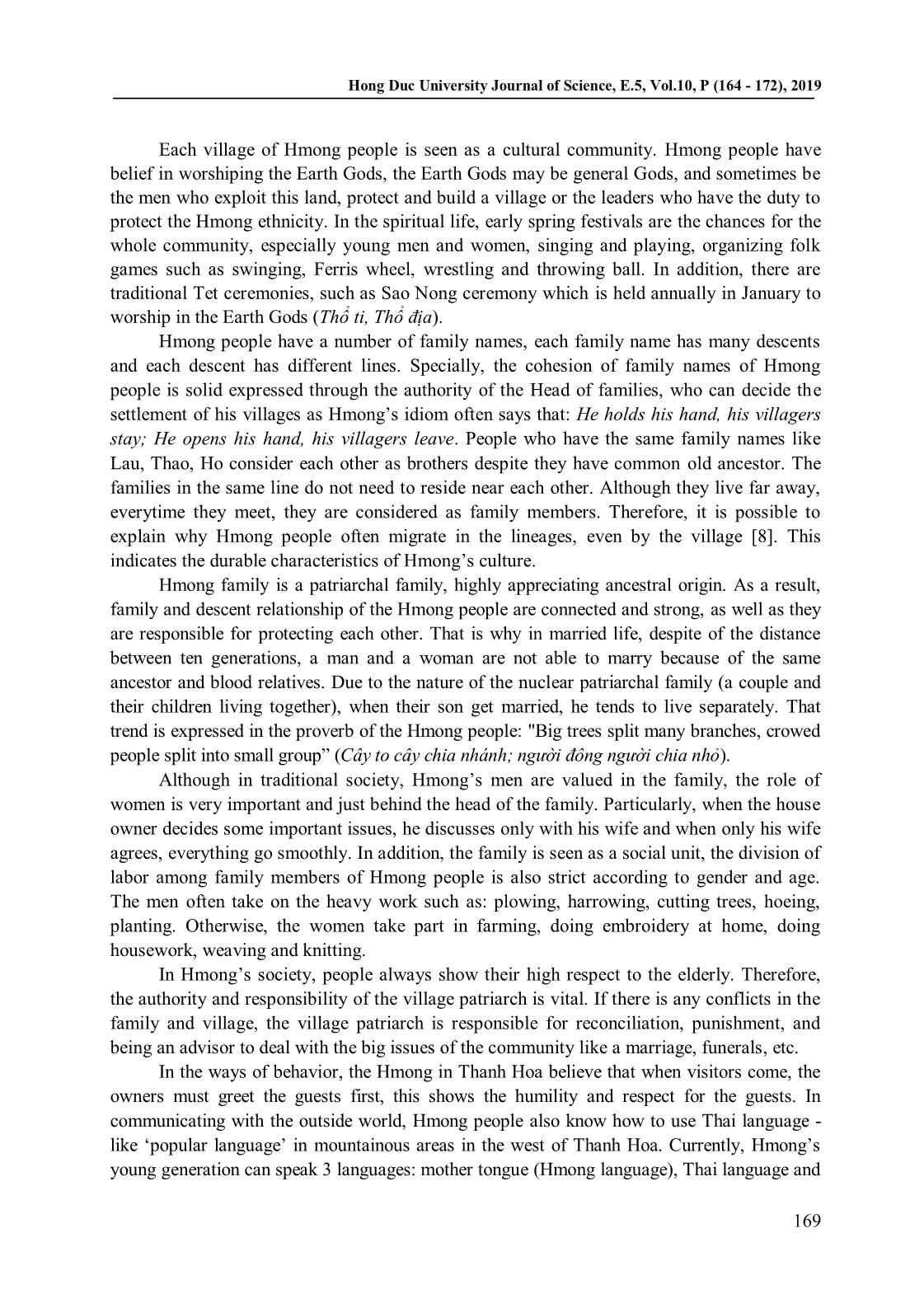
Trang 6
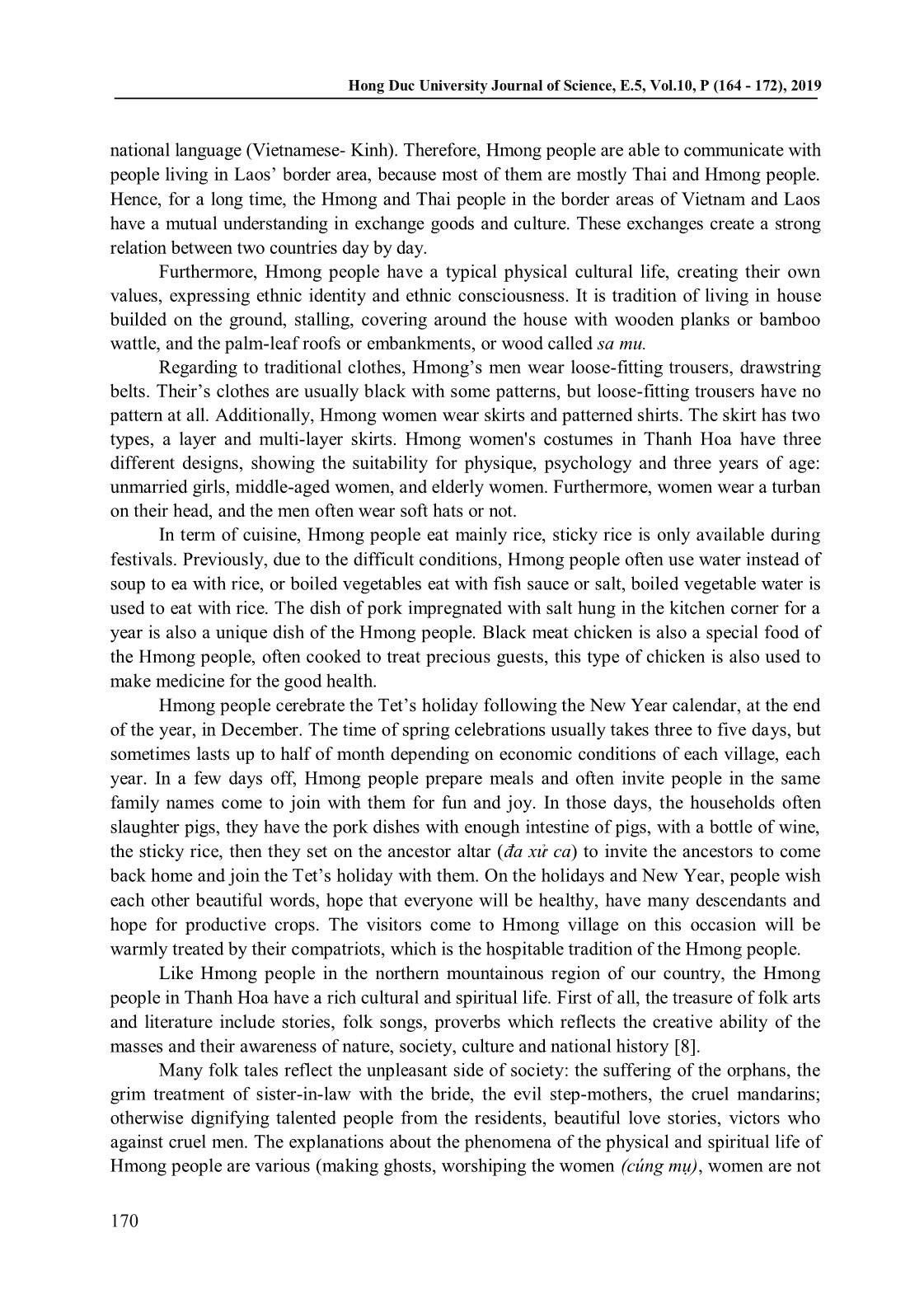
Trang 7
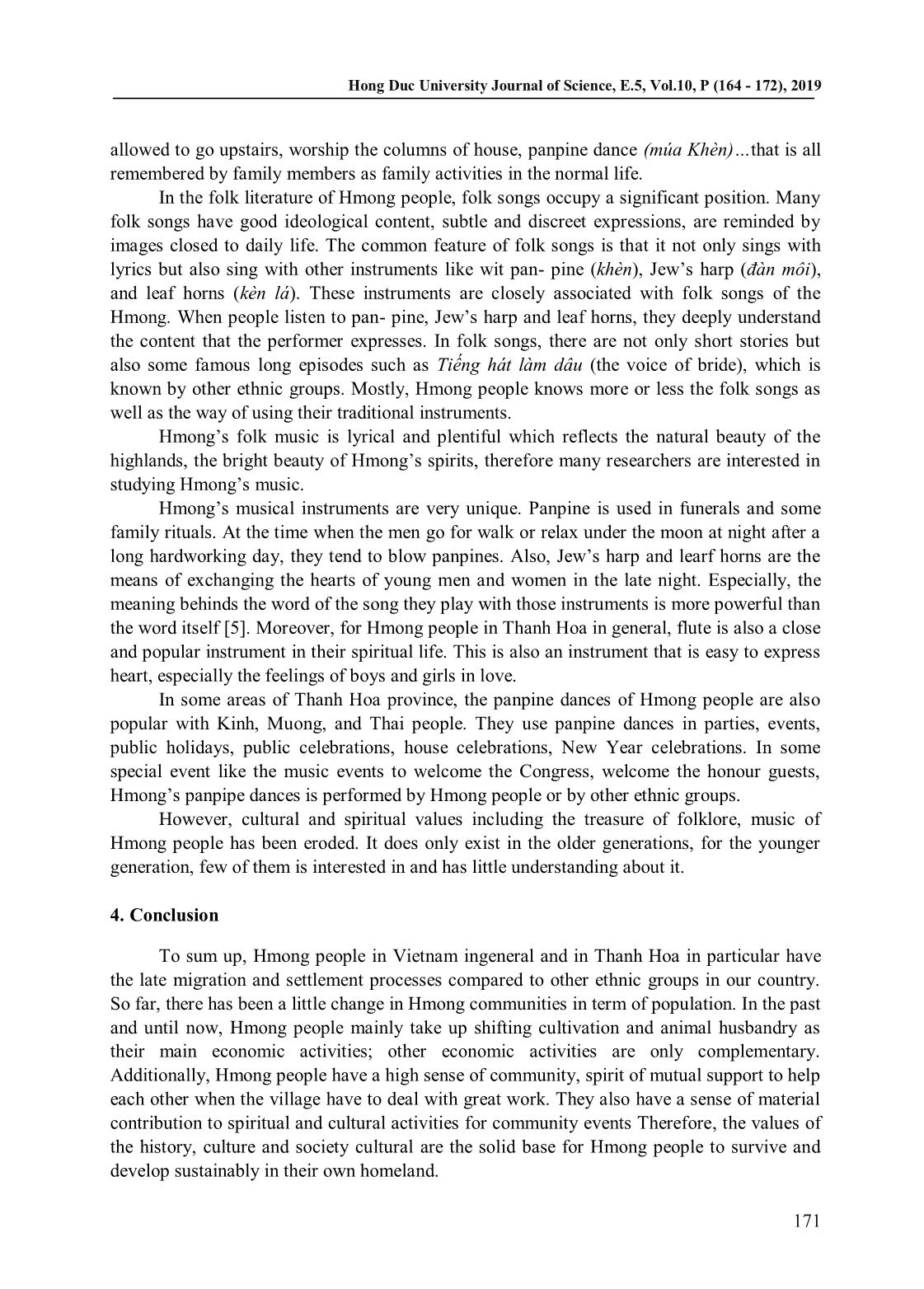
Trang 8
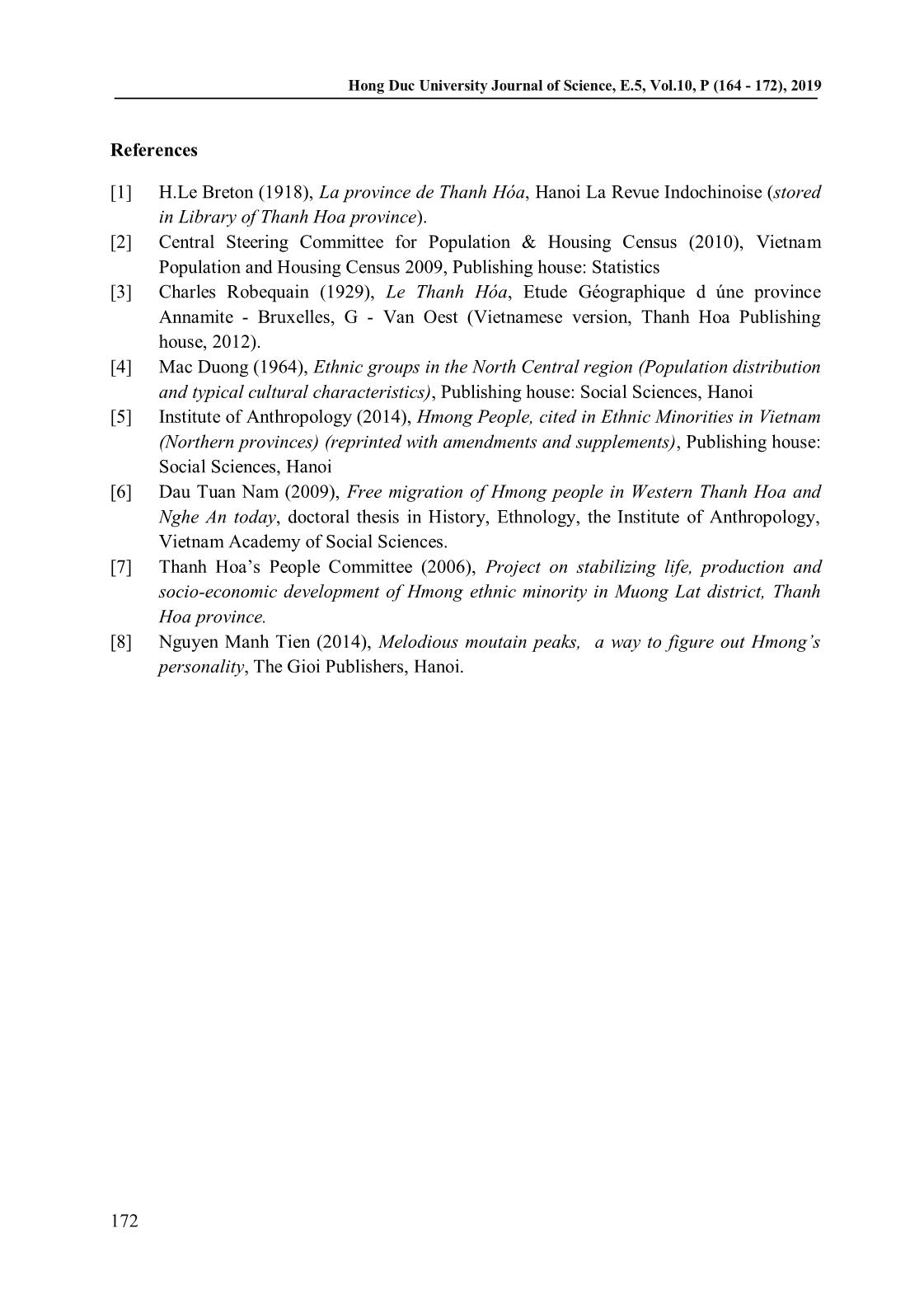
Trang 9
Tóm tắt nội dung tài liệu: An overview of history, culture and society of Hmong people in Thanh Hoa
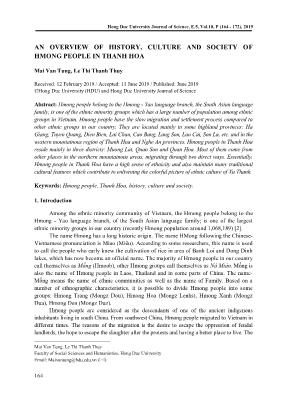
mong Trang people (Mongz Dou) have the largest population and the Hmong Den (Mongz Duz) people have the smallest population. The Hmong people in Thanh Hoa have many families such as Ho, Thao, Lau, Va, Cha, Ly, Vu, Vang, and Dang. The most populous families are Lau, Ho and Thao. Due to living in high mountainous areas, their livelihood mainly is on shifting cultivation activities combined with raising, gardening and forest exploitation. Basically, Hmong ethnic community in Thanh Hoa preserve many traditional cultures, contributing to 168 enriching the diversity of the muti-colour cultural picture of Xu Thanh ethnic communities. 3. Cultural and social characteristics of Hmong in Thanh Hoa Like the Hmong people living in our northwest region, the resident unit of the Hmong people in Thanh Hoa likes the village of Kinh and Thai people. Hmong Trang people (Mongz Dou) call their village as lú ro and Hmong Den (Mongz Duz) people called it as lu rò. However, because of living alongside with Thai people for a long time, Hmong people often call their resident units as same as Thai people do, namely Ché Lau, Xia Non, Mua Xuan, Pu Ngua, and Lo Ha villages... Each village of the Hmong usually has more than 10 rooftops in one place or in many places. The characteristic of the Hmong‟s village is that they have their own territory and business areas; the residents of a village consist of many family names and there is one more crowed family than others; each village has a common Earth Gods (head of the territory) and common conventions related to agricultural production, animal husbandry, forest protection and mutual help. 168 Hong Duc University Journal of Science, E.5, Vol.10, P (164 - 172), 2019 Each village of Hmong people is seen as a cultural community. Hmong people have belief in worshiping the Earth Gods, the Earth Gods may be general Gods, and sometimes be Fac. ofFac. Grad. Studies, Mahidol Univ. M.M. (International the men who exploit this land, protect and build a village or the leaders who have the duty to protect the Hmong ethnicity. In the spiritual life, early spring festivals are the chances for the whole community, especially young men and women, singing and playing, organizing folk games such as swinging, Ferris wheel, wrestling and throwing ball. In addition, there are traditional Tet ceremonies, such as Sao Nong ceremony which is held annually in January to worship in the Earth Gods (Thổ ti, Thổ địa). Hmong people have a number of family names, each family name has many descents and each descent has different lines. Specially, the cohesion of family names of Hmong people is solid expressed through the authority of the Head of families, who can decide the settlement of his villages as Hmong‟s idiom often says that: He holds his hand, his villagers stay; He opens his hand, his villagers leave. People who have the same family names like Lau, Thao, Ho consider each other as brothers despite they have common old ancestor. The families in the same line do not need to reside near each other. Although they live far away, everytime they meet, they are considered as family members. Therefore, it is possible to explain why Hmong people often migrate in the lineages, even by the village [8]. This indicates the durable characteristics of Hmong‟s culture. Hmong family is a patriarchal family, highly appreciating ancestral origin. As a result, HospitalityManagement) / family and descent relationship of the Hmong people are connected and strong, as well as they are responsible for protecting each other. That is why in married life, despite of the distance between ten generations, a man and a woman are not able to marry because of the same ancestor and blood relatives. Due to the nature of the nuclear patriarchal family (a couple and their children living together), when their son get married, he tends to live separately. That trend is expressed in the proverb of the Hmong people: "Big trees split many branches, crowed people split into small group” (Cây to cây chia nhánh; người đông người chia nhỏ). Although in traditional society, Hmong‟s men are valued in the family, the role of 169 women is very important and just behind the head of the family. Particularly, when the house owner decides some important issues, he discusses only with his wife and when only his wife agrees, everything go smoothly. In addition, the family is seen as a social unit, the division of labor among family members of Hmong people is also strict according to gender and age. The men often take on the heavy work such as: plowing, harrowing, cutting trees, hoeing, planting. Otherwise, the women take part in farming, doing embroidery at home, doing housework, weaving and knitting. In Hmong‟s society, people always show their high respect to the elderly. Therefore, the authority and responsibility of the village patriarch is vital. If there is any conflicts in the family and village, the village patriarch is responsible for reconciliation, punishment, and being an advisor to deal with the big issues of the community like a marriage, funerals, etc. In the ways of behavior, the Hmong in Thanh Hoa believe that when visitors come, the owners must greet the guests first, this shows the humility and respect for the guests. In communicating with the outside world, Hmong people also know how to use Thai language - like „popular language‟ in mountainous areas in the west of Thanh Hoa. Currently, Hmong‟s young generation can speak 3 languages: mother tongue (Hmong language), Thai language and 169 Hong Duc University Journal of Science, E.5, Vol.10, P (164 - 172), 2019 national language (Vietnamese- Kinh). Therefore, Hmong people are able to communicate with people living in Laos‟ border area, because most of them are mostly Thai and Hmong people. Fac. ofFac. Grad. Studies, Mahidol Univ. M.M. (International Hospitality Management) / Hence, for a long time, the Hmong and Thai people in the border areas of Vietnam and Laos have a mutual understanding in exchange goods and culture. These exchanges create a strong relation between two countries day by day. Furthermore, Hmong people have a typical physical cultural life, creating their own values, expressing ethnic identity and ethnic consciousness. It is tradition of living in house builded on the ground, stalling, covering around the house with wooden planks or bamboo wattle, and the palm-leaf roofs or embankments, or wood called sa mu. Regarding to traditional clothes, Hmong‟s men wear loose-fitting trousers, drawstring belts. Their‟s clothes are usually black with some patterns, but loose-fitting trousers have no pattern at all. Additionally, Hmong women wear skirts and patterned shirts. The skirt has two types, a layer and multi-layer skirts. Hmong women's costumes in Thanh Hoa have three different designs, showing the suitability for physique, psychology and three years of age: unmarried girls, middle-aged women, and elderly women. Furthermore, women wear a turban on their head, and the men often wear soft hats or not. In term of cuisine, Hmong people eat mainly rice, sticky rice is only available during festivals. Previously, due to the difficult conditions, Hmong people often use water instead of soup to ea with rice, or boiled vegetables eat with fish sauce or salt, boiled vegetable water is used to eat with rice. The dish of pork impregnated with salt hung in the kitchen corner for a year is also a unique dish of the Hmong people. Black meat chicken is also a special food of the Hmong people, often cooked to treat precious guests, this type of chicken is also used to make medicine for the good health. Hmong people cerebrate the Tet‟s holiday following the New Year calendar, at the end of the year, in December. The time of spring celebrations usually takes three to five days, but sometimes lasts up to half of month depending on economic conditions of each village, each year. In a few days off, Hmong people prepare meals and often invite people in the same 170 family names come to join with them for fun and joy. In those days, the households often slaughter pigs, they have the pork dishes with enough intestine of pigs, with a bottle of wine, the sticky rice, then they set on the ancestor altar (đa xử ca) to invite the ancestors to come back home and join the Tet‟s holiday with them. On the holidays and New Year, people wish each other beautiful words, hope that everyone will be healthy, have many descendants and hope for productive crops. The visitors come to Hmong village on this occasion will be warmly treated by their compatriots, which is the hospitable tradition of the Hmong people. Like Hmong people in the northern mountainous region of our country, the Hmong people in Thanh Hoa have a rich cultural and spiritual life. First of all, the treasure of folk arts and literature include stories, folk songs, proverbs which reflects the creative ability of the masses and their awareness of nature, society, culture and national history [8]. Many folk tales reflect the unpleasant side of society: the suffering of the orphans, the grim treatment of sister-in-law with the bride, the evil step-mothers, the cruel mandarins; otherwise dignifying talented people from the residents, beautiful love stories, victors who against cruel men. The explanations about the phenomena of the physical and spiritual life of Hmong people are various (making ghosts, worshiping the women (cúng mụ), women are not 170 Hong Duc University Journal of Science, E.5, Vol.10, P (164 - 172), 2019 allowed to go upstairs, worship the columns of house, panpine dance (múa Khèn)that is all remembered by family members as family activities in the normal life. Fac. ofFac. Grad. Studies, Mahidol Univ. M.M. (International In the folk literature of Hmong people, folk songs occupy a significant position. Many folk songs have good ideological content, subtle and discreet expressions, are reminded by images closed to daily life. The common feature of folk songs is that it not only sings with lyrics but also sing with other instruments like wit pan- pine (khèn), Jew‟s harp (đàn môi), and leaf horns (kèn lá). These instruments are closely associated with folk songs of the Hmong. When people listen to pan- pine, Jew‟s harp and leaf horns, they deeply understand the content that the performer expresses. In folk songs, there are not only short stories but also some famous long episodes such as Tiếng hát làm dâu (the voice of bride), which is known by other ethnic groups. Mostly, Hmong people knows more or less the folk songs as well as the way of using their traditional instruments. Hmong‟s folk music is lyrical and plentiful which reflects the natural beauty of the highlands, the bright beauty of Hmong‟s spirits, therefore many researchers are interested in studying Hmong‟s music. Hmong‟s musical instruments are very unique. Panpine is used in funerals and some family rituals. At the time when the men go for walk or relax under the moon at night after a long hardworking day, they tend to blow panpines. Also, Jew‟s harp and learf horns are the means of exchanging the hearts of young men and women in the late night. Especially, the HospitalityManagement) / meaning behinds the word of the song they play with those instruments is more powerful than the word itself [5]. Moreover, for Hmong people in Thanh Hoa in general, flute is also a close and popular instrument in their spiritual life. This is also an instrument that is easy to express heart, especially the feelings of boys and girls in love. In some areas of Thanh Hoa province, the panpine dances of Hmong people are also popular with Kinh, Muong, and Thai people. They use panpine dances in parties, events, public holidays, public celebrations, house celebrations, New Year celebrations. In some special event like the music events to welcome the Congress, welcome the honour guests, 171 Hmong‟s panpipe dances is performed by Hmong people or by other ethnic groups. However, cultural and spiritual values including the treasure of folklore, music of Hmong people has been eroded. It does only exist in the older generations, for the younger generation, few of them is interested in and has little understanding about it. 4. Conclusion To sum up, Hmong people in Vietnam ingeneral and in Thanh Hoa in particular have the late migration and settlement processes compared to other ethnic groups in our country. So far, there has been a little change in Hmong communities in term of population. In the past and until now, Hmong people mainly take up shifting cultivation and animal husbandry as their main economic activities; other economic activities are only complementary. Additionally, Hmong people have a high sense of community, spirit of mutual support to help each other when the village have to deal with great work. They also have a sense of material contribution to spiritual and cultural activities for community events Therefore, the values of the history, culture and society cultural are the solid base for Hmong people to survive and develop sustainably in their own homeland. 171 Hong Duc University Journal of Science, E.5, Vol.10, P (164 - 172), 2019 References [1] H.Le Breton (1918), La province de Thanh Hóa, Hanoi La Revue Indochinoise (stored ofFac. Grad. Studies, Mahidol Univ. M.M. (International Hospitality Management) / in Library of Thanh Hoa province). [2] Central Steering Committee for Population & Housing Census (2010), Vietnam Population and Housing Census 2009, Publishing house: Statistics [3] Charles Robequain (1929), Le Thanh Hóa, Etude Géographique d úne province Annamite - Bruxelles, G - Van Oest (Vietnamese version, Thanh Hoa Publishing house, 2012). [4] Mac Duong (1964), Ethnic groups in the North Central region (Population distribution and typical cultural characteristics), Publishing house: Social Sciences, Hanoi [5] Institute of Anthropology (2014), Hmong People, cited in Ethnic Minorities in Vietnam (Northern provinces) (reprinted with amendments and supplements), Publishing house: Social Sciences, Hanoi [6] Dau Tuan Nam (2009), Free migration of Hmong people in Western Thanh Hoa and Nghe An today, doctoral thesis in History, Ethnology, the Institute of Anthropology, Vietnam Academy of Social Sciences. [7] Thanh Hoa‟s People Committee (2006), Project on stabilizing life, production and socio-economic development of Hmong ethnic minority in Muong Lat district, Thanh Hoa province. [8] Nguyen Manh Tien (2014), Melodious moutain peaks, a way to figure out Hmong’s personality, The Gioi Publishers, Hanoi. 172 172
File đính kèm:
 an_overview_of_history_culture_and_society_of_hmong_people_i.pdf
an_overview_of_history_culture_and_society_of_hmong_people_i.pdf

